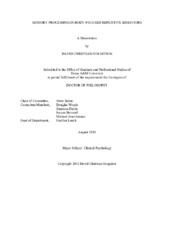| dc.description.abstract | Body-focused repetitive behaviors (BFRBs) such as hair pulling and skin picking
are common practices that are part of ordinary grooming, but can proliferate excessively
into maladaptive habits. Despite their negative consequences, affected individuals often
experience great difficulty in stopping pulling/picking and report strong urges and
hedonic reward associated with symptoms. Unfortunately, the psychobiological
mechanisms underlying sensory features of BFRBs have been insufficiently studied. The
current study aimed to explore potential sensory processing abnormalities in adults with
Trichotillomania and Excoriation Disorder using several self-reported instruments and a
vibrotactile behavioral battery. A total of 46 adults with either Trichotillomania or
Excoriation Disorder were recruited, along with an age-matched sample of 46 healthy
control participants. Participants completed clinician-rated interviews regarding their
symptom severity and self-report instruments regarding interoceptive awareness and
sensory gating. The vibrotactile battery consisted of several tests that assessed reaction
time, sensorimotor integration, detection threshold, feed-forward inhibition, lateral
inhibition, temporal processing, and duration discrimination.
Persons with BFRBs reported increased interoceptive awareness, a greater
propensity to worry about their body states, and less trust in their own body. In addition,
the BFRB group reported greater perceptual inundation, sensory distractability, overinclusion,
and a propensity to experience sensory abnormalities while fatigued or
distressed. Persons with BFRBs did not display behavioral deficits in sensorimotor
integration, quickly adapting lateral inhibition, temporal processing, or duration
discrimination. However, the BFRB group had lower tactile thresholds and deficient
feed-forward inhibition. Deficient feed-forward inhibition was correlated with skin
picking severity. These findings indicate that increased sensitivity to sensory stimuli and
an inability to filter out excess sensory input is associated with a propensity to engage in
BFRBs, perhaps as a method of distracting oneself from an aversive perceptual state. | en |


